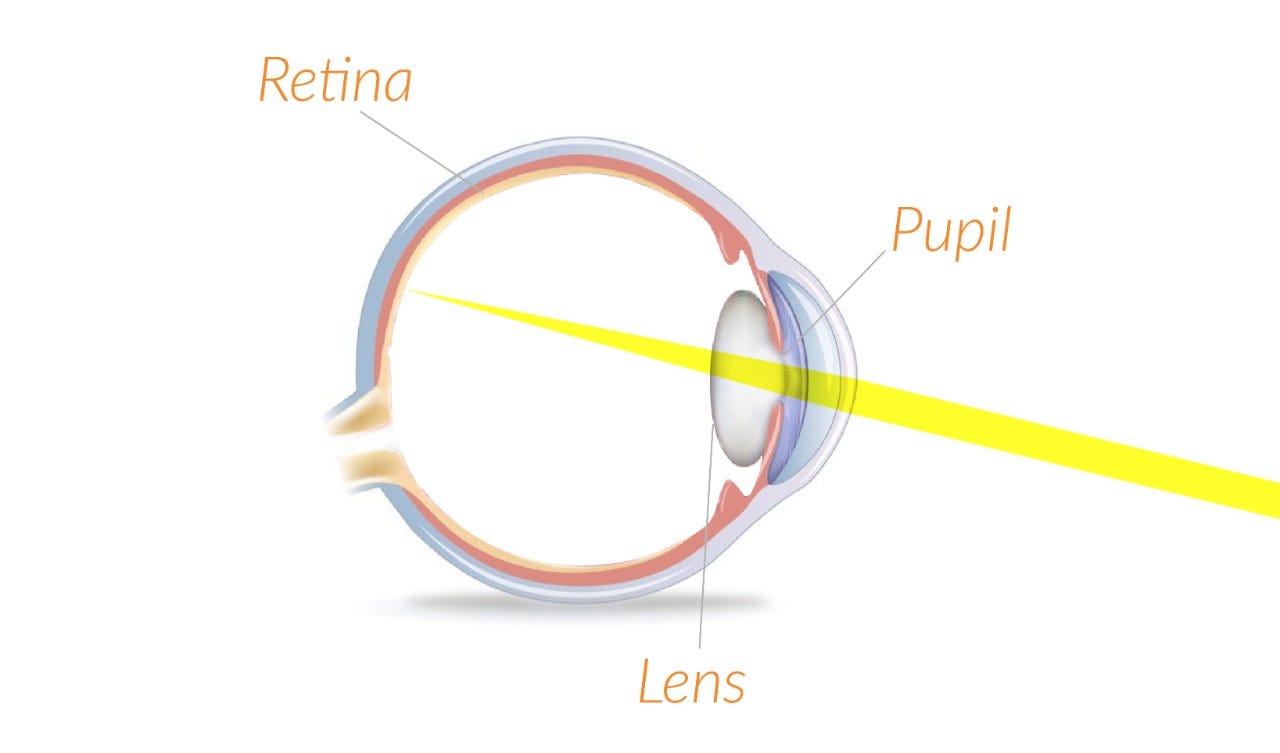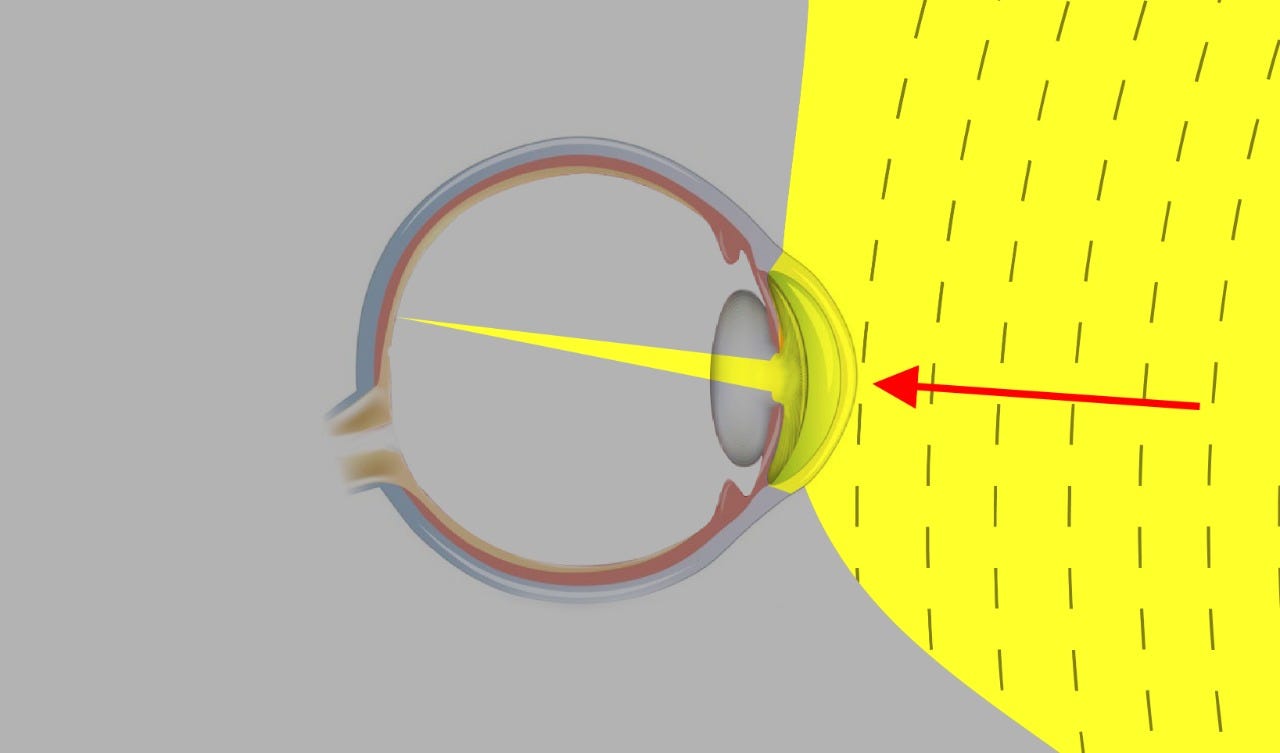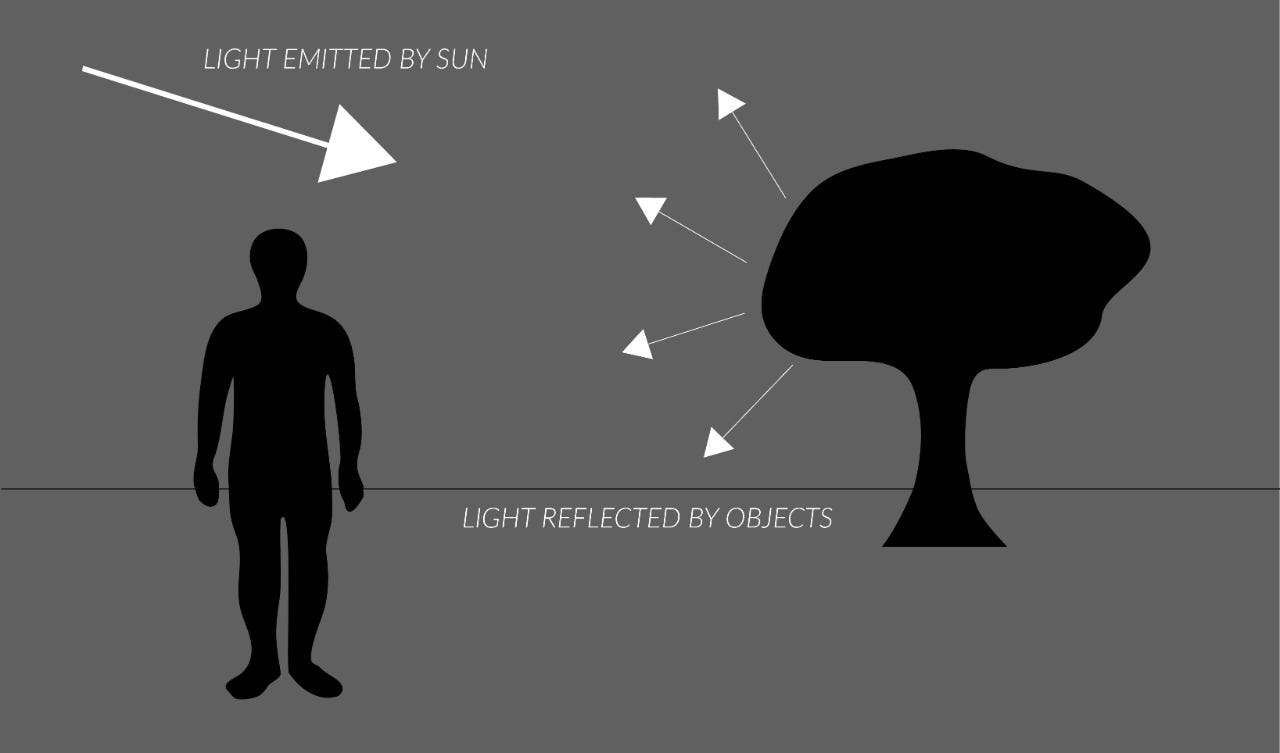What Is Light? Finally, a Simple Explanation.
set 12 2025By Marcos Chiquetto

Our bodies have wonderful resources that we use without even thinking about them. But, if we stop to consider it, we realize that their functions are so complex and efficient that it’s hard to imagine how they could have developed.
One example of this is the human eye.

All of us had biology classes where we learned about how the human eye works. We learned that light enters the eye through the pupil and passes through a lens that focuses images on the retina.

Comparing this to a movie theater, the lens is just like the lens of a projector, the eyeball is the theater, and the retina is the screen onto which the images are projected.
From the retina, the optic nerve carries nerve impulses to the brain which creates colors and images of objects in our mind. I haven’t the slightest idea of how the brain does this. When I think about it, it takes me to a wonderful and mysterious world of the unknown.
But for this article, let’s stick to the eyes and light.
So, what is light?
To start with, let’s remember that light is an electromagnetic wave*.
To see a concrete example of what a wave is, look at this photo that shows waves created on the surface when a drop falls into a body of water:

These waves were created by disturbances on the surface of water. Electromagnetic waves have a similar origin: They are created when protons or electrons undergo some disturbance. For example, in a light bulb, electrons emit light when they are put into motion by electrical energy.
The following figure shows the electromagnetic waves created by a light bulb when it is turned on. Compare it to Figure 3.

The waves appear in this figure as circles. But the light bulb illuminates the whole room, which means that the waves are spherical, expanding in three dimensions. The gray tones do not represent more or less light, but the different intensities of the electromagnetic fields. The sensation of light is only produced in the brain when these waves hit the retina.
The waves fill the entire space, but only a thin beam passes through the pupil. Figure 2 is represented more correctly this way:

Figura 6 depicts an example that could match the drawing on figure 5:

Stop reading right here and look at a light bulb that is turned on. Imagine the waves coming out of it and travelling through space like spherical surfaces that grow in size as they leave the bulb. Imagine a straight beam of these waves entering your eye through your pupil, being focused by your lens, and forming an image on your retina, exactly as it would on a screen at the theater.
Returning to figure 4, you can see that the wave fronts (circumferences that are the peaks of the waves in the water) are always the same distance from each other. This distance is the “wavelength”.
Electromagnetic waves can have wavelengths that run from billionths of a meter to centimeters, meters, or kilometers. For every wavelength, the wave has different properties.
The figure that follows presents the electromagnetic spectrum, which includes all of the wavelengths of electromagnetic waves and how each interval is referred to.


The following figure shows a close up of the range that corresponds to visible light. It extends from approximately 400 nm (400 nanometers, or 0.0000004 m) to 750 nm (0.00000075 m). Depending on the wavelength within this range, our brain produces the sensation of different colors.

— So, the light that I can see has a wavelength that measures in millionths of a meter? This is the distance between the wavefronts when I see a light bulb that is turned on?
Yes, the wave fronts of the light in figure 5 are separated by millionths of a meter. In an X-ray machine, the wavelengths are even smaller than that, while a microwave antenna used in cellular telephone networks transmits waves whose wavelengths are measured in centimeters. And a radio broadcast uses waves with wavelengths on the order of meters or more.
But what I’d like to ask here is: why is it that only waves with these wavelengths are perceptible to our eyes? What makes light light? Why does light illuminate objects?
To find an answer to this, lets observe a graph that illustrates the intensity of the electromagnetic waves reaching our planet coming from the Sun, as a function of their wavelengths:

You can see that the intensity of the waves coming from the Sun is at its greatest exactly in the range that corresponds to visible light. Could that be a coincidence?
What I’m going to say next is a personal hypothesis. I haven’t looked for bibliographic references to support it. This hypothesis is based upon Charles Darwin’s theory of natural selection, which he proposed in 1859 in his book “On the Origin of Species”.
Living beings must be able to move about, or navigate in space, in order to defend themselves against predators or to seek food. At some point in evolution, a certain species may have undergone a mutation that involved the development of a tissue that was sensitive to electromagnetic waves. As our planet is constantly inundated by electromagnetic waves coming from the Sun, the ability to sense these waves created a competitive advantage, allowing this species to hunt and to avoid predators more efficiently. Because of natural selection, this advantage favored the preservation of this particular species in detriment to others that were less well adapted.
But these waves are present in greater quantity in the range that corresponds to the radiation coming from the Sun. Thus, individuals of that species in which this tissue was more sensitive to this same range of waves had an advantage over others, because it had a greater intensity of waves at its disposition to help it navigate, enabling it to survive and reproduce in accordance with the process of natural selection. Thus, as generation followed generation, this tissue continued to become increasingly tuned to the waves in this range, as if it were a radio receiver tuned to a certain station. Over the course of millions of years, this system for perception of electromagnetic waves evolved into the eyes we are now familiar with and that species from a faraway time gave rise to the animals of our era that possess the sense of sight.

The conclusion then, is the following: light isn’t light because of some intrinsic characteristics it possesses. What makes light light is our retina, which, after millions of years of evolution, has become tuned to the wavelengths that are most abundant on our planet, and our brain, which is able to create forms in our minds as a result of this interaction.
What’s more, in addition to being able to detect the most abundant waves that surround us, we are also able to differentiate between the various wavelengths in a continuous scale of colors. A plant isn’t green because of any intrinsic characteristics it has, but simply because our brain identifies that particular wavelength and our culture gave this identification the name of “green”.
Trying to imagine the process of evolution through which those primitive tissues were transformed until they became eyes, with a pupil, lens, and retina, is extremely difficult. When I try to understand it, this evolution seems impossible. Small genetic mutations giving rise to more adaptable species, that survive while others disappear, seems like a process that could never lead to the development of something so complex as an eye.
But then we have to consider another factor that is equally difficult to conceive of: a process that is carried out over tens of millions of years. This is another concept that I find difficult to get my brain around.
And this is without even starting to consider the ear, which has exactly the same function except that it uses sound waves. And without considering that we have two eyes and two ears which enable us to identify the direction from which the waves are coming. And these wonders go on and on.
This world of wonders leaves me awestricken.
…
* The concept of light as electromagnetic waves comes from Classical Physics, developed by the end of the 19th Century. According to Quantum Physics, the more recent theory, light also has properties of particles. But the classical concept works for this discussion.
* If you know a little about basic Physics, you know that we can identify electromagnetic waves by frequency, which is inversely proportional to the wavelength. Thus, red has a lower frequency and violet has a higher frequency, or the frequency increases from red to violet. This makes the terms “infrared” and “ultraviolet” seem more logical.

I am an engineer, physics teacher, translator, and writer. I am also director of LatinLanguages, a translation agency that provides multilingual companies and final clients with translation into Portuguese and Spanish. If you work with these languages, we are your best option—delivering world-class service at Brazilian prices.
Marcos Chiquetto




